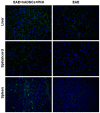Therapeutic effects of human adipose tissue-derived stem cell (hADSC) transplantation on experimental autoimmune encephalomyelitis (EAE) mice
- PMID: 28198408
- PMCID: PMC5309875
- DOI: 10.1038/srep42695
Therapeutic effects of human adipose tissue-derived stem cell (hADSC) transplantation on experimental autoimmune encephalomyelitis (EAE) mice
Abstract
This study is to investigate the therapeutic effects of human adipose tissue-derived stem cell (hADSC) transplantation on experimental autoimmune encephalomyelitis (EAE) in mice. EAE mouse model was established by MOG35-55 immunization. Body weight and neurological function were assessed. H&E and LFB staining was performed to evaluate histopathological changes. Flow cytometry was used to detect Th17 and Treg cells. ELISA and real-time PCR were performed to determine transcription factor and pro-inflammatory cytokine levels. Transplantation of hADSCs significantly alleviated the body weight loss and neurological function impairment of EAE mice. Inflammatory cell infiltration and demyelination were significantly increased, which were relieved by hADSC transplantation. Moreover, the Th17 cells and the ROR-γt mRNA level were significantly elevated, while the Treg cells and the Foxp3 mRNA level were significantly declined, resulting in significantly increased Th17/Treg ratio. This was reversed by the transplantation of hADSCs. Furthermore, serum levels of IL-17A, IL-6, IL-23, and TGF-β, were significantly increased, which could be influenced by the hADSC transplantation. Transplantation of hADSCs alleviates the neurological function impairment and histological changes, and reduces the inflammatory cell infiltration and demyelination in EAE mice, which might be associated with the regulation of Th17/Treg balance.
Conflict of interest statement
The authors declare no competing financial interests.
Figures







References
-
- Lassmann H., Van Horssen J. & Mahad D. Progressive multiple sclerosis: pathology and pathogenesis. Nat Rev Neurol. 8, 647–656 (2012). - PubMed
-
- Gaillard P. J. et al.. Glucocorticoid and type 1 interferon interactions at the blood-brain barrier: relevance for drug therapies for multiple sclerosis. Neuroreport. 12, 2189–2193 (2001). - PubMed
-
- Littman D. R. & Rudensky A. Y. Th17 and regulatory T cells in mediating and restraining inflammation. Cell. 140, 845–858 (2010). - PubMed
Publication types
MeSH terms
Substances
LinkOut - more resources
Full Text Sources
Other Literature Sources
Medical

